ISSN ONLINE(2319-8753)PRINT(2347-6710)
ISSN ONLINE(2319-8753)PRINT(2347-6710)
| V. Karthik Assistant professor, Department of ECE, Sri Krishna College of Engineering and Technology, Coimbatore, India |
| Related article at Pubmed, Scholar Google |
Visit for more related articles at International Journal of Innovative Research in Science, Engineering and Technology
Data collection process is one of the important aspects in the design consideration for future analysis in wireless sensor networks. Energy consumption by parent node increases due to continuous forwarding of sensed data from their respective child nodes especially in the tree based topology. Once the energy in the parent nodes was completely drained off, some of the child nodes get isolated/ partitioned from the sink node. The proposed data collection method involves deployment of multiple mobile robots whose responsibility is to collect the data from the nodes whose energy is below the threshold value. Navigation of mobile robots to collect the data from partitioned nodes usually achieved by time and location based strategies. In proposed hybrid scheduling, the navigation of mobile robots scheduled by both the combination of time and location based approaches with multiple region scheduling. In large network scenario, the mobile robot gets more burdens due to its more responsibilities to visit all partitioned nodes. So the entire scenario is divided in to different regions and the deployment of multiple mobile robots is based on the requirements. Therefore, the efficiency of sensed data collected by the base station or sink node from partitioned/islanded WSN is improved doubly using multiple mobile robots. Through simulation under the environment of NS-2 simulator, the results from various aspects show that proposed multiple mobile robots can improve the performance of collecting the sensed data in large-scale sensing fields and also it improves the lifetime of the sensor nodes.
Keywords |
| Multiple mobile robots, Wireless Sensor Network, Data collection process, Region Based approach, Hybrid Scheduling |
INTRODUCTION |
| Wireless Sensor Networks (WSNs) mechanism is quite simply applicable to a variety of fields. It is based on smaller nodes, radio transceiver, and battery. The wireless sensor networks perform function in autonomous manner in the spatial field to get accurate values. Wireless Sensor Networks (WSNs) are a relatively new application in the network which provides high quality monitoring for large geographical areas with relatively inexpensive equipment. The technology involves deploying a large number of small, inexpensive nodes over the area. Each node is equipped with one or several sensors with a short range radio. The challenges in WSN include processing power, transmission bandwidth, memory, battery etc. A sensor node needs to possess knowledge of its physical location in space. Location awareness is not only needed when reporting the geographical origin of events, but is critical in many other aspects of sensor networks as well. It can assist in routing in large scale sensor networks or be used to study the coverage properties of the network. Based on the knowledge of their own location, a group of node can discover the direction of the target movement and wakeup other nodes (which are in sleep mode to conserve power) to continue the tracking task. Furthermore, any dynamic technique must take into account the low-power constraints that govern every aspect of sensor networks. For the consideration of sensor network scenario which based on tree topology, the chid nodes gathered the sensed information and forward it to the base station through the parent node. The tree topology is for detail analysis about energy consumption by the nodes and data integration process.Energy depletion in parent node leads to dead mode then their child nodes unable to communicate with sink. So, some group of sensor nodes unexpectedly partition or left as island WSNs. Consequently, the sensed data collected by the partitioned/islanded WSNs will be discarded; therefore, the base station collects only part of the sensed data, which are collected by those sensor nodes seen by the base station. To alleviate this difficulty, a mobile robot (MR) is employed to assist in collecting data in partitioned/islanded WSNs and to bring collected sensed data back to the sink. The locations of partitioned/islanded WSNs are obtained by the global-based approach (GBA) and the local-based approach (LBA), Reference [1]. The difference between these two control approaches is based on the threshold energy of the sensor node that results in the partitioned/islanded WSN. GBA gives the indication of threshold of energy level breakdown, and then it is followed by LBA once the energy is drained off and even there is no control message forward to the sink. This indication can be issued to prolong the lifetime of a sensor node by shuttling the Mobile Robot (MR) to the desired locations. MR is nothing but sensor node with mobility which having capability to collect the data from child nodes whose parent energy level is below the threshold value. Once the locations of the partitioned/islanded WSN are determined, navigation strategies can be scheduled. |
II. PARTITIONED WSN |
| Consider the sensor network scenario with tree based topology which having one sink node/ base station with four parent nodes. Each parent node having link to one or more child nodes as shown in figure 1. |
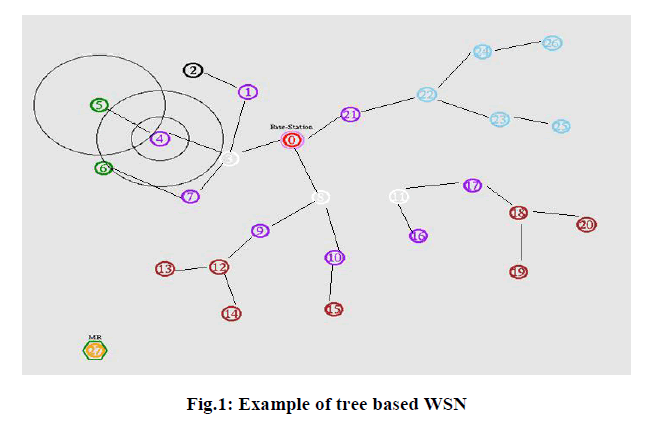 |
| In the above figure Node 0 is sink node and node 3, 8, 11, and 21 are parent nodes. Their corresponding child nodes are shown through the link as shown in Fig 1. Consider energy of node 11 is drain off entirely which result in partitioned WSN, node 11, 16, 17, 18, 19 and 20 are set of sensor nodes in partitioned WSNs. In partitioned network sensed data from other nodes are temporary collected by previous node of the parent node. After mobile robot visit the parent node, MR gets the gathering information from that pervious node of parent node in partitioned network. For example consider partitioned network nodes 11, 16, 17, 18, 19 and 20. In this node 11 is dead node. So, sensed data from 17, 18, 19 and 20 nodes are temporary collected by node 16 which is previous node of the parent node. After mobile robot visit the node 11, MR gets the gathering information from node 16 in that partitioned network. Furthermore, thresholds of energy of the senor node are defined by two factors named as near death node and death node. Node 27 is mobile robot (MR). The radio range of sensor nodes 4 and 5 is shown in the above figure 1. Mobile robots are navigated to the desired location by the sink node based on identifying partitioned/isolated locations. The desired locations are obtained by the two approaches namely global based and local based approaches, Reference [1]. |
III. SINGLE MOBILE ROBOT |
| Energy consumption by parent node increases due to continuous forwarding of sensed data from their respective child nodes. Parent nodes like near death node and death nodes locations will be found with the help of GBA and LBA. The partitioned WSNs can be identified without difficulty, and the related information, location, and time, can be collected by the sink of the WSN. However, the status of sensor nodes in the WSN changes from time to time. Navigation of mobile robot by three phases the initial phase, the collection phase, and the return phase. During the initial phase, the MR needs to communicate with the sink to gather sensed information, including geographic locations and time, of the death node and near death node, to determine which sensor node will be visited first, and to clear all the sensed data that have been sent to the sink for a fresh run. During the collection phase, the MR will collect the sensed data and control packets, as needed, from the local sinks. When the control packets have been collected and updated, the information of the death node and near death node will be stacked. During this phase, the MR will compute the next sensor node visit according to the pre-designated navigation strategies, and whether the sensor nodes with the status of death node and near death node have been visited yet. For example, during the initial phase, the sink knows only that the WSN has three partitioned WSNs, 3, 8, and 11. Assuming that the first visiting partitioned WSN is 11, and partitioned WSNs 3 and 8 occurred while the MR was in the collection phase, the MR will determine the next sensor node to visit after collecting the required information from the local sink of 11. Thus, after re-computation by the MR, the partitioned WSN 3 will be visited next by the MR, etc. The return phase indicates that the sink has collected sufficiently sensed data and control packets for returning to the sink. During this phase, the sink will obtain the sensed data and information from the MR to update the death node and near death node tables for the next run of the MR. With the information of the partitioned WSNs, the MR is applied as a mobile sink to the locations of the partitioned WSNs and collects sensed data and control packets to return to the sink. In this section, navigation strategy is proposed hybrid scheduling which is combination of location-based scheduling (LBS) and Time based scheduling (TBS). |
A. Time-Based Scheduling |
| Time-based scheduling (TBS) is based on the time a node becomes the status of death node and near death node. For example the MR will visit nodes given based on that death time as following The death time of Node 3 = 13.514967 sec, The death time of Node 8 = 11.667856 sec, The death time of Node 11 = 14.64585 sec. Fig. 1 shows that nodes 3, 8, and 11 are denoted as death node and the values of Death time for each node are in the order of node 8 < node 3 < node11. Considering above death time of parent nodes, node 8 is first death node or going to dead node (near death node) before node 3 and node 11. So, the mobile robot visit node 8 first and then MR visit node 3 and node 11 for data gathering process. |
B. Location-Based Scheduling |
| In most situations, the distance between the death node and the sink of the WSN is considered. Thus, locationbased scheduling (LBS), based on the distance between the sink and the death node and near death node, is essential. LBS is set to command the MR to visit the nearest the death node and near death node first to collect required information. The Euclidean distance formula calculates the distance between the sink and the location of the death node and near death node. For example, distance between sink and the dead node/near dead node as follows Distance between sink and node (3) = 200, Distance between sink and node (8) = 235, Distance between sink and node (11) = 377, Fig. 2 shows that the distances of nodes 3, 8 and 11 between the sink are in the order of distance (3) < distance (8) < distance (11). Node 3 is less distance to the sink, when comparing distance between parent node and sink. So, the mobile robot visit node 3 first and then MR visit node 8 and node 11 for data gathering process. The mobile robot visiting parent nodes based on the priority of the distance. |
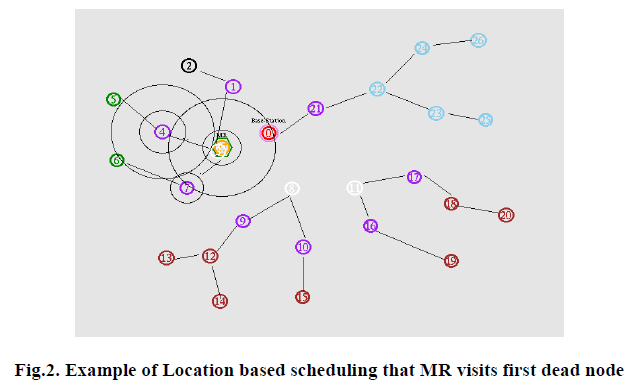 |
| Fig.2. shows that MR visits first dead node based on Location based scheduling. The distance between dead node 3 and sink node 0 is 200 calculated by the Euclidean distance formula. Similarly, Fig.3 shows that MR visits second dead node based on Location based scheduling. The distance between dead node 8 and sink node 0 is 235 calculated by the Euclidean distance formula. After visiting all dead nods finally MR reach sink and bring back the gathered data to sink node. Then next round again it will find dead nodes and then MR visit partitioned nodes. Similarly MR gathering sensed information. |
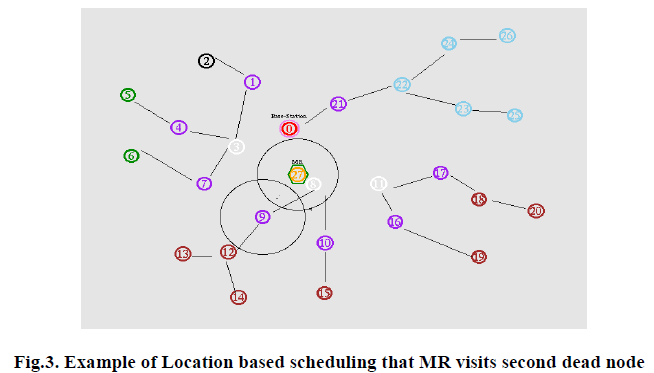 |
IV. MULTIPLE MOBILE ROBOT |
| Large scale network have more number of nodes with more dead nodes. Single mobile robot cannot manage all death nodes. So we required multiple mobile robots for data collection process in large area network. Navigation of multiple mobile robots is done by new proposed strategy called hybrid based approach. Hybrid Based Scheduling (HBS) is combination of both TBS and LBS. If there is more number of nodes is failure in the network, multiple robots used for separate partition in order to collect data. In this HBS module the mobile robot retrieves location of death node from sink, based on the death nodes distances from sink the Mobile robots visit those partition dynamically. It will also visit those partition based on distance between itself (MR) and death node. This HBS approach is combination of both TBS and LBS with multiple mobile robots. |
A. Region-Based Approach |
| Mobile robot is generated to collect the information from partitioned/isolated child nodes. Single mobile robot navigation method is insufficient and may leads to increase the burden of MR for the large network scenario. To avoid this deficiency multiple mobile robot can be used. In this approach two or more mobile robots are generated. For the large network analysis, multiple mobile robot is effective but there may conflict that where to collect the data in the available area. So the entire network is sub-divided in to regions in which mobile robots are allotted to collect data from pre -defined regions. This method helps for multiple robots implementation by region based approach with hybrid based scheduling (HBS).The regions are assigned based on available nodes in the network. Mobile Robots are generated based on allocated regions. Consider the network with one base station (sink) and many sensor nodes that are deployed in tree based structure. Due to multiple mobile robots implementation the large scale sensor nodes are grouped into some regions called AREAs. Sensor network is separated into 3 groups that are AREA A, AREA B, AREA C as shown in Fig 4.1 In this method the time taken to reach the collected data from in death chid to the sink increases. In the region based approach the multiple mobile robots are deployed per region to accumulate the sensed data from the parent nodes whose threshold of energy is very low. For the consideration of fig 4.1 the entire region is formed in to 3 AREAs. So here we required 3 mobile robots for data collection process. These mobile robots have high radio rang for contact nearest mobile robot. So the sensed information passes through one mobile robot to another finally mobile robot which is nearest of sink node bring back sensed data to sink node. The MR designed in such a way that it moves horizontally across the network in straight path at both direction as shown in fig 4.2. |
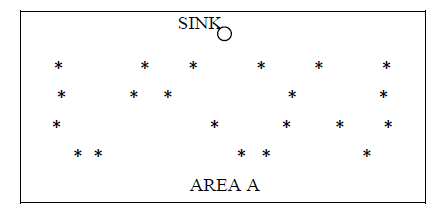 |
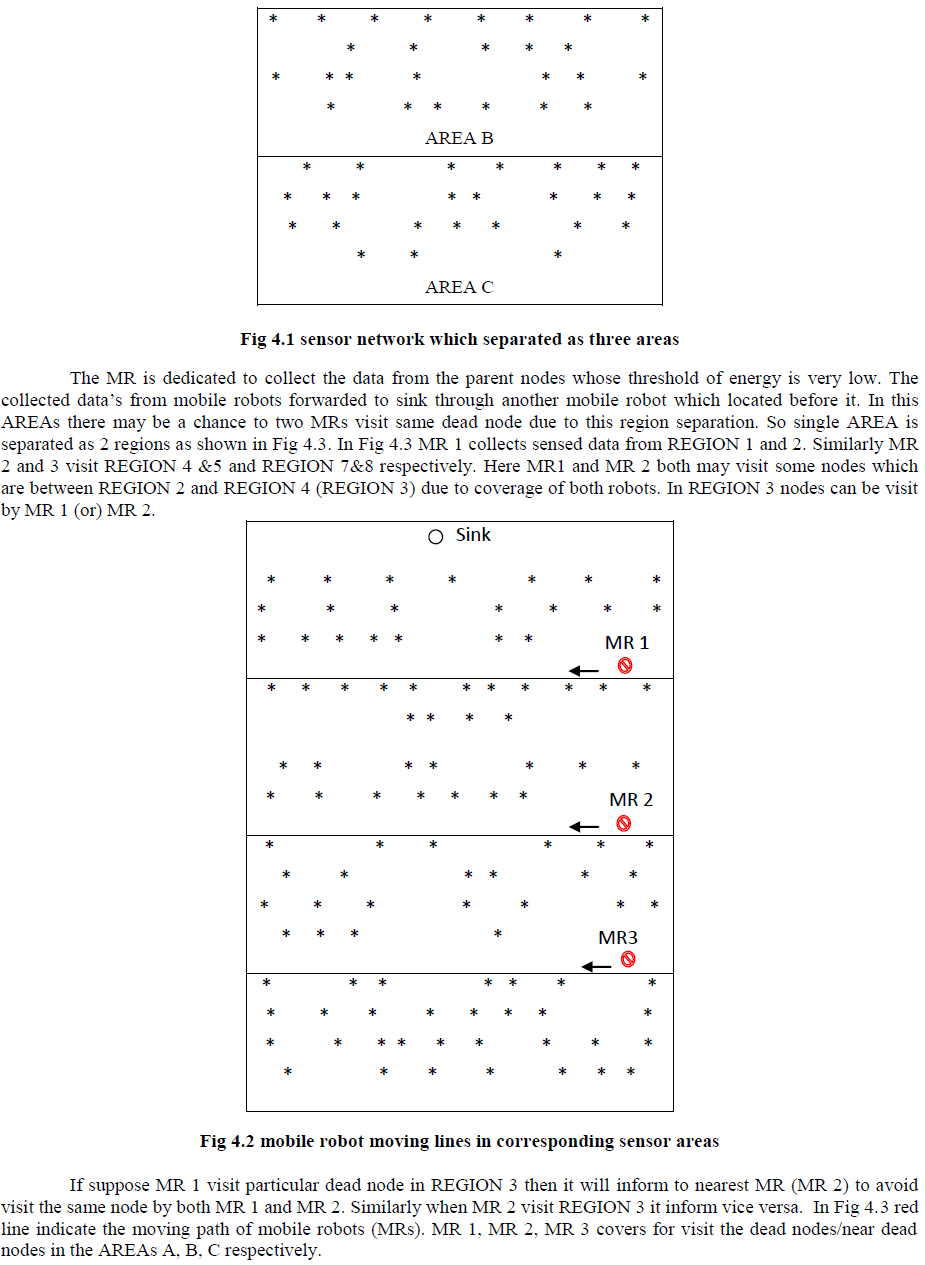 |
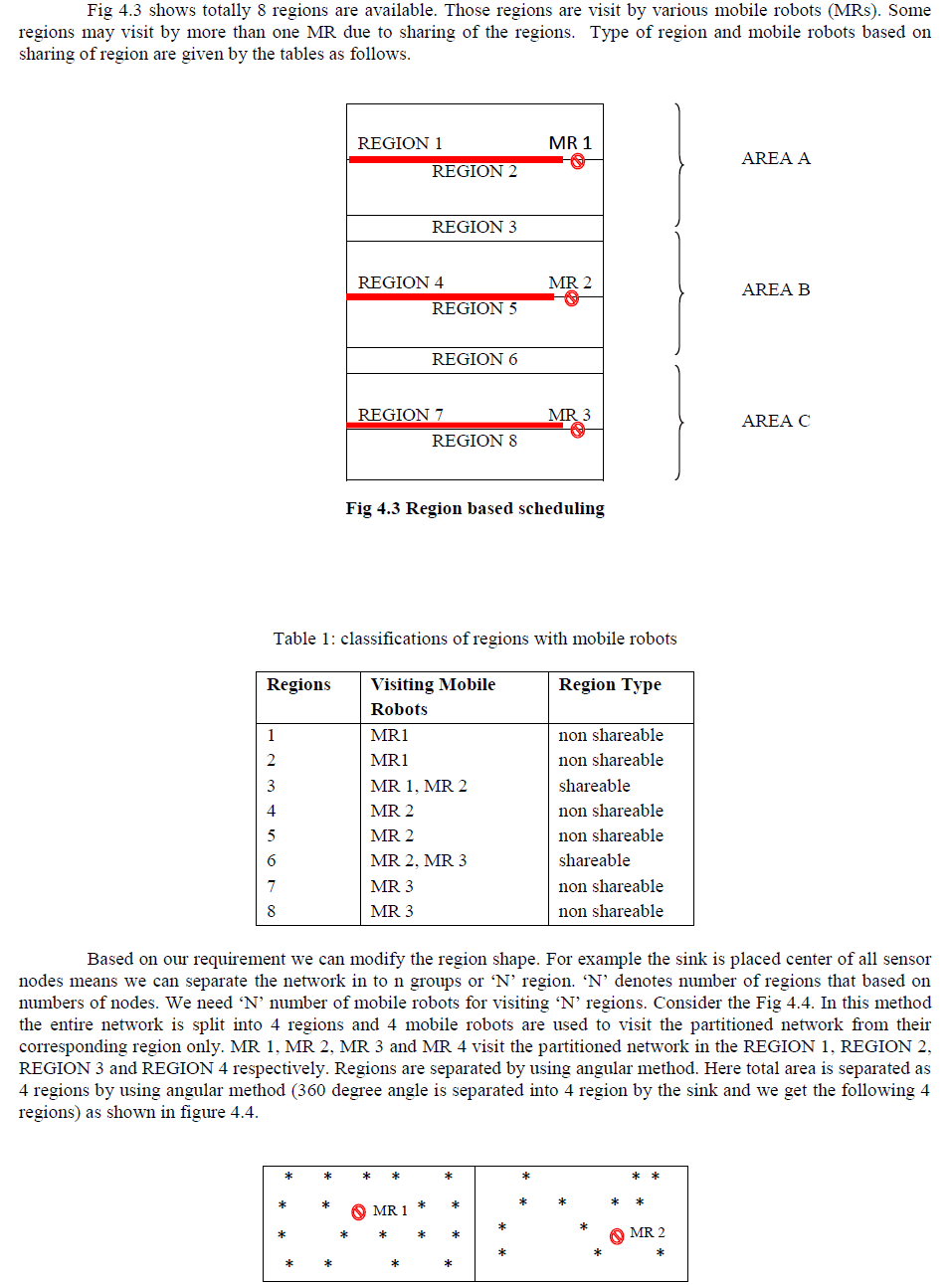 |
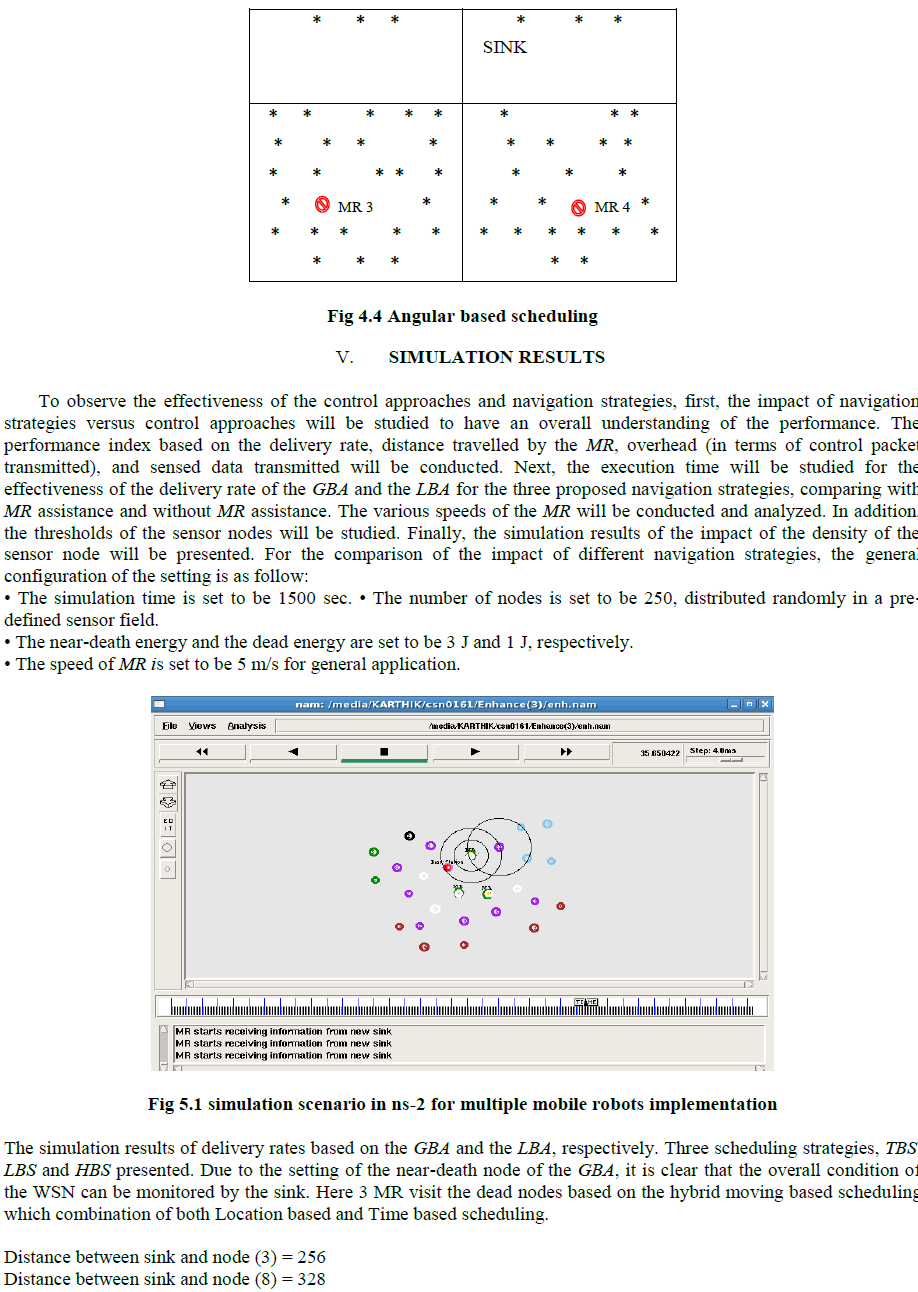 |
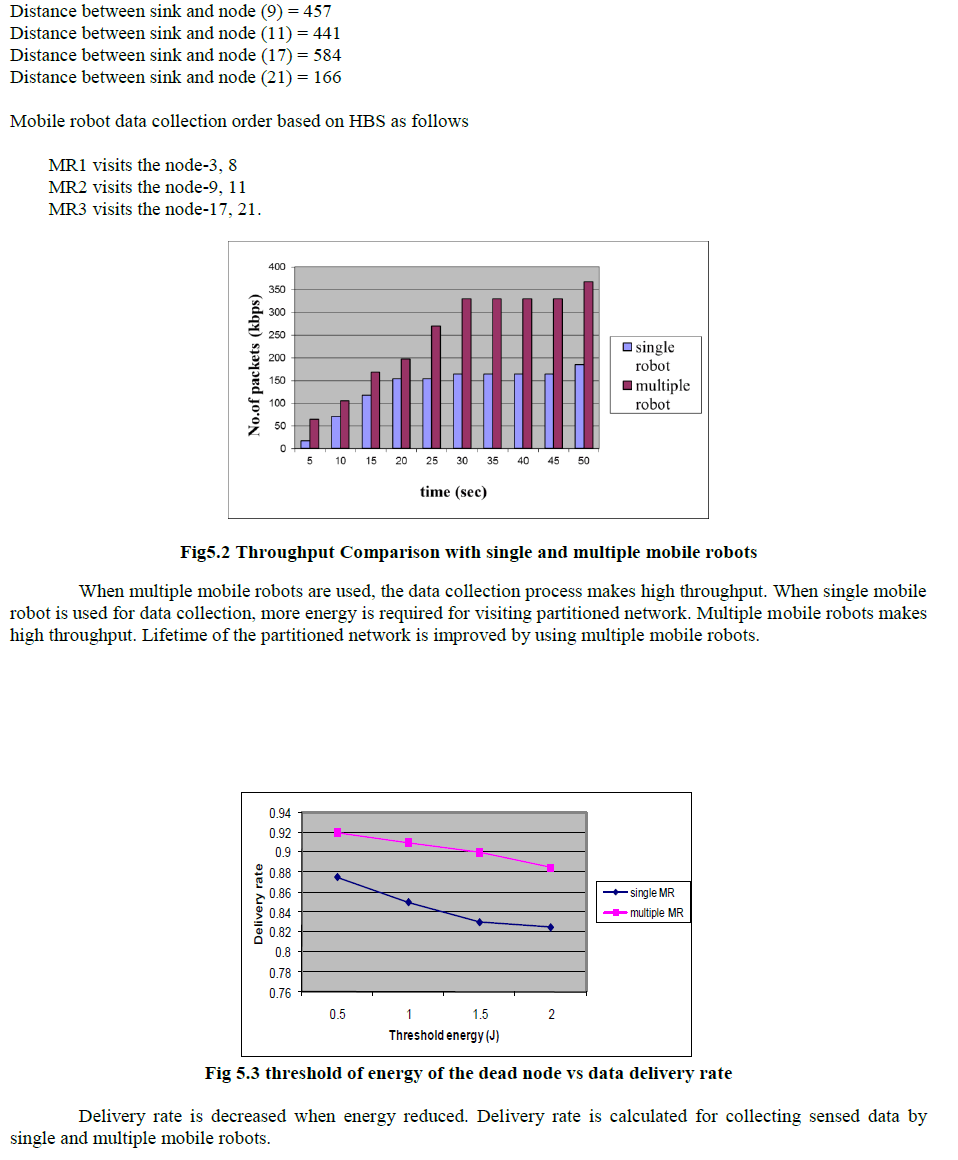 |
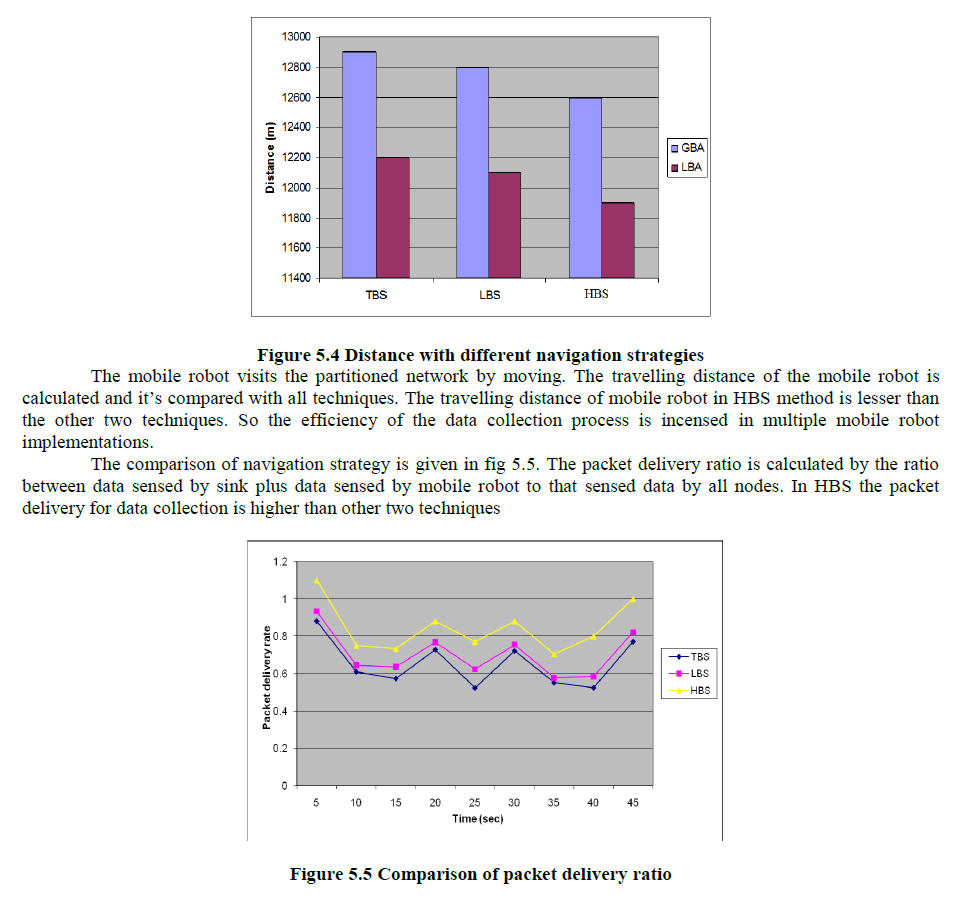 |
VI. CONCLUSION |
| Hybrid moving based scheduling strategy for data collection process is improved lifetime of the network. For large coverage area and more number of nodes failure in the network, multiple mobile robots used for separate partition in order to collect data. This multiple robot implementation is done by region based approach and angular based algorithm. The performance of the proposed strategy is shown to have improved using multiple MR in a WSN. The experimental results showed that the proposed algorithms the efficiency of sensed data collected by the base station in partitioned/islanded WSN is improved doubly using multiple mobile robots. The proposed mobile robot data collection is analyzed by using multiple mobile robots, in case of more number of node failures in large scale network. |
A. Future Work |
| The clustering formation reduces the number of dead nodes in the partitioned network. The partitioned nodes are converted to clustering after that the cluster head collects the sensed data to communicate with mobile robot. Due to this process the numbers of dead nodes are decreased in the partitioned network. |
References |
|